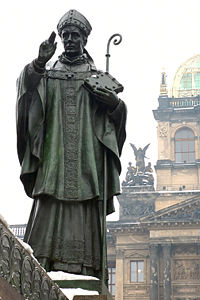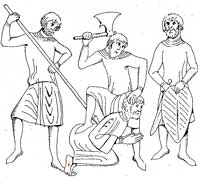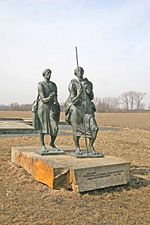| Saint Adalbert of Prague | |
|---|---|
|
|
|
| Apostle of Prussia | |
| Born | c. 956 in Libice nad Cidlinou, Bohemia |
| Died | 997 in Truso (Elbląg) or Kaliningrad Oblast |
| Venerated in | Roman Catholic Church |
| Canonized | 999 by Pope Sylvester II |
| Major shrine | Gniezno, Prague |
| Feast | April 23 |
| Patronage | Bohemia; Poland; Prussia |
Adalbert (born Vojtěch; c. 956–April 23, 997) was a high-born Czech who served his faith as a bishop of Prague and a Benedictine monk. In spite of his efforts, he was martyred during his mission to convert the Baltic Prussians—a mission that had been instigated by the king of Poland Bolesław I the Brave. For his service to the Catholic Church, he was was posthumously honored as the patron saint of Bohemia, Poland, Hungary, and Prussia. His feast day is celebrated on April 23.
Biography
Early life
Vojtěch was born into the noble family of Prince Slavnik and his wife Střezislava in Libice nad Cidlinou, Bohemia.[1] As was common at the time, Radzim and Vojtěch, two of the prince's sons, were groomed for ecclesiastical careers.[2] Of the two, Vojtěch was an exceptionally well-educated man, having studied for about ten years (970-80) in Magdeburg under Saint Adalbert of Magdeburg, who so impressed his young pupil that he chose to take his mentor's name at his confirmation. Gifted and industrious, though lacking in an overarching goal or vision, Adalbert Vojtěch completed his studies and took up the carefree life of a man of arms (ca. 980).[3][4]
Religious career
Though Adalbert's future seemed both joyful and boundless, he was soon afflicted with a surfeit of personal tragedies. In 981, both the saint's father (Prince Slavnik) and his eponymous mentor died. Not long after, he was also witness to the agonizing demise of Bishop Thietmar of Prague, with whom he had developed a strong relationship. Despite his own feelings of unreadiness, he was named Thietmar's successor, a post that he accepted with utmost gravity.[5] Taking up his newfound responsibilities, Adalbert made it a personal goal to rectify the Christianity of his home diocese—a task that was made considerably more challenging due to the prevalence of pre-Christian ("pagan") beliefs in the area. Though he developed a certain notoriety for his impassioned preaching and his devotion to the poor, his attempts to encourage ecclesiastical reform (such as priestly celibacy) earned him many enemies (including many members of the Bohemian nobility).[6] Growing deeply discouraged at the seeming failure of his efforts, the young bishop eventually resigned from his office and left Prague (989), traveling to Rome and taking up residence in the Benedictine monastery of St. Alexis.[7]
Though the future saint would have been content to spend the remainder of his days in quiet study and contemplation, it was simply not to be. Four years later (993), Pope John XV, who was dissatisfied with the condition of the Christian faith in the Slavic world, forcefully reminded Adalbert about his commitment to the people of Bohemia. In the face of such an order, Adalbert resumed his ecclesiastical duties. This time, he founded a monastery in Břevnov, near Prague, the first such institution in Czech lands. However, his ministry continued to face the same kind of opposition that he had encountered earlier. For this reason, high clerical office was a burden to Adalbert, and in 994 he offered it to Strachkvas (who was both a Přemyslid and Duke Boleslav's brother). In spite of the power and prestige attached to the position, Strachkvas refused.[8]
During this period, the bishop also incited the ire of many locals by offering sanctuary to a noblewoman accused of adultery. When the unruly mob broke into his home, absconded with the woman and murdered her, Adalbert publicly excommunicated them—an act that redoubled the venom of many noble families.[9]
In 995, Slavniks' former rivalry with the Přemyslids resulted in the storming of Libice and a cruel murder of four (or five) of Adalbert's brothers. All this was done by the will of Boleslav II of Bohemia, and the key executioners were his confederates from a powerful clan of Vršovci. Thus the Zličan princedom became part of the Přemyslids' estate. The episode involving the adulterous woman is often thought to have been the "tipping point" that initiated this massacre.[10]
After the tragedy (and fearing for his own safety), Adalbert could no longer remain in Bohemia. So, he escaped from Prague and returned to the Roman monastery that had been his home six years previous. While there, he made to acquaintance of Emperor Otto III, with whom he shared a grandiose vision of the unification of Europe under the banner of Christianity.[11] Emboldened by this council, Adalbert traveled to Hungary, stopping to baptize Géza of Hungary and his son Stephen in the city of Esztergom. He then continued on to Poland, where he was cordially welcomed by Bolesław I the Brave.[12]
Mission and martyrdom in Prussia
Though Adalbert had originally been ordered to return to the decidedly unwelcoming city of Prague, Pope Gregory V took note of his missionary successes in Hungary and suggested that he next begin to proselytize the Prussians.[13] Fortunately, the itinerant bishop had the support of Boleslaus the Brave, duke of Poland, who sent his soldiers to alongside the missionary's party. Sallying forth, the group, which included the saint's half-brother Radzim (Gaudentius), entered Prussian territory near Gdańsk and ventured along the coast of the Baltic Sea.
Though his mission was initially successful, earning convert in Danzig and elsewhere, the ill-fated Adalbert eventually came to rouse the suspicion of the locals, who accused him of being a Polish spy. When he continued to preach among their people, ignoring their threats, he and his companions were summarily executed on April 23, 997, somewhere in the vicinity of Koenigsberg.[14]
Canonization and Legacy
In 999, scarcely two years after his death, Adalbert was canonized as Saint Adalbert of Prague by Pope Sylvester II. His life was extensively documented in various versions of the Vita Sancti Adalberti, some of the earliest being written by Roman monk John Canaparius (ca. 1000) and Saint Bruno of Querfurt (ca. 1001-1004).[15]
The current ruling family of Bohemia, the Přemyslids, initially refused to pay the Prussians for the return of Saint Adalbert's body, which led it being ransomed by the Poles.[16] Thus, Saint Adalbert's relics came to be stored in Gniezno, which helped Boleslaus the Brave to improve Poland's reputation as a devout Christian nation.[17] However, their final resting place was disturbed in 1039, when the Bohemian duke Bretislav I retrieved them by force and moved them to Prague.[18] According to another version, he took only some of the sainted bones, while the rest (including the skull) were hidden by the Poles and found in 1127.[19]
June 1997 was the thousandth anniversary of Saint Adalbert's martyrdom. It was commemorated in the Czech Republic, Poland, Germany, Russia and other countries. Representatives of Catholic, Greek Orthodox, and Evangelical churches embarked on pilgrimages to Gniezno, to the saint's tomb. John Paul II visited Gniezno and held a ceremonial divine service in which heads of seven European states and about a million believers took part.[20] In Kaliningrad Oblast, near Beregovoe village (former Tenkitten), where Adalbert's death hypothetically took place, a ten-meter cross was established. As Butler summarizes:
- The importance of St. Adalbert in the history of central Europe has perhaps been insufficiently appreciated. He was intimate with the Emperor Otto III, and appears to have entered into that monarch's scheme for a renovatio imperii Romanorum and the christianization and unification of the remoter parts of Europe. Adalbert sent missionaries to the Magyars and visited them himself, and was the "remote" inspiration of King Saint Stephen. … His memory was influential in Poland, where the foundation of a monastery, either at Miedrzyrzecze in Poznania or at Trzmeszno, is attributed to him. There was some cultus of him even in Kiev. … [A]bove all he was a holy man and a martyr, who gave his life rather than cease to witness Christ; and the wide extent of his cultus is the measure of his appreciation.[21]
Notes
- ↑ The prince had no shortage of heirs, as Vojtěch had five full brothers: Soběbor (Slavnik's next-of-kin), Spytimir, Pobraslav, Porej, Caslav and a half-brother Radzim Gaudenty (from his father's liaison with another woman).
- ↑ The phenomenon of courtier-bishops is discussed at length in C. Stephen Jaeger's article, "The Courtier Bishop in Vitae from the Tenth to the Twelfth Century." Speculum 58 (2) (April 1983): with specific mention of Adalbert on page 300 (ff. 26).
- ↑ Sabine Baring-Gould. The Lives of the Saints. With introduction and additional Lives of English martyrs, Cornish, Scottish, and Welsh saints, and a full index to the entire work. (Edinburgh, UK: J. Grant, 1914) , 311
- ↑ David Hugh Farmer. The Oxford Dictionary of Saints. (Oxford; New York: Oxford University Press, 1997), 3. A more complete account of his illustrious family's history can be found in the Chronica Boëmorum, accessible online (in the original Latin) at Monumenta Germaniae Historica.Retrieved March 17, 2008.
- ↑ Baring-Gould notes that his youthful gaiety was abruptly silenced by the responsibilities of this new appointment (311). Likewise, Butler quotes from one of the Vitae of the saint to similar effect: "It is easy to wear a mitre and carry a crozier," Adalbert was heard to say, "but it is a terrible thing to have to give account of a bishopric to the Judge of the Living and the Dead" (152).
- ↑ T.J. Campbell. "Saint Adalbert" in The Catholic Encyclopedia. (1910); Butler, 152.
- ↑ Baring-Gould, 312. While many accounts suggest that Adalbert left Bohemia of his own volition, Farmer opines that he was "exiled in 990 by nationalist opposition (3).
- ↑ Monumenta Germaniae Historica.
- ↑ Farmer, 4; Butler, 153.
- ↑ Farmer, 4; Butler, 153.
- ↑ Farmer, 4; Baring-Gould, 312.
- ↑ Butler, 153.
- ↑ Specifically, the pope explicitly rescinded his previous order with the realization that "to go amongst [the Bohemians] against their will was only to provoke further bloodshed" (Butler, 153).
- ↑ Farmer, 4; Butler, 153. Campbell (1910) offers a less politicized view of the saint's death: "Success attended his efforts at first, but his imperious manner in commanding them to abandon paganism irritated them, and at the instigation of one of the pagan priests he was killed."
- ↑ Butler, 153.
- ↑ As Campbell (1910) notes, "Boleslas I, Prince of Poland, is said to have ransomed his body for an equivalent weight of gold."
- ↑ The political context of the contest of the saint's relics is explored in Dvornik's essay: "When in the year 1000 the emperor arrived in Gnesen to do honor to the relics of his intimate friend, Saint Adalbert of Prague, who, in trying to convert the Prussians, had suffered a martyr's death at their hands, Otto III was welcomed by the Poles with a great demonstration. Gnesen was made a metropolis and a Polish hierarchy was established, independent of Madgeburg and of the German Church, while Boleslas the Great became Patricius of the Roman Empire and an ally of the emperor" (471).
- ↑ Farmer, 4; Butler, 153.
- ↑ As per the Roczniki Polskie.
- ↑ For the text of Pope John Paul II's homily, see "Homily at Mass in honor of Saint Adalbert asking for prayers for the Church in Czechoslovakia," Osservatore Romano (English), 1038: 2(May 9 1988).
- ↑ Butler, 153.
References
ISBN links support NWE through referral fees
- Attwater, Donald and Catherine Rachel John. The Penguin Dictionary of Saints, 3rd edition. New York: Penguin Books, 1993. ISBN 0140513124.
- Baring-Gould, S. (Sabine). The Lives of the Saints. With introduction and additional Lives of English martyrs, Cornish, Scottish, and Welsh saints, and a full index to the entire work. Edinburgh: J. Grant, 1914.
- Butler, Alban. Lives of the Saints, Edited, revised, and supplemented by Herbert Thurston and Donald Attwater. Palm Publishers, 1956.
- Campbell, T. J. "Saint Adalbert" in The Catholic Encyclopedia. 1909.
- Chronica Boëmorum, accessible online (in the original Latin) at Monumenta Germaniae Historica. Retrieved March 17, 2008.
- Dvornik, F. "Western and Eastern Traditions of Central Europe." The Review of Politics 9 (4)(October 1947): 463-481.
- Farmer, David Hugh. The Oxford Dictionary of Saints. Oxford; New York: Oxford University Press, 1997. ISBN 0192800582.
- Jaeger, C. Stephen. "The Courtier Bishop in Vitae from the Tenth to the Twelfth Century." Speculum 58 (2) (April 1983): 291-325.
Credits
New World Encyclopedia writers and editors rewrote and completed the Wikipedia article in accordance with New World Encyclopedia standards. This article abides by terms of the Creative Commons CC-by-sa 3.0 License (CC-by-sa), which may be used and disseminated with proper attribution. Credit is due under the terms of this license that can reference both the New World Encyclopedia contributors and the selfless volunteer contributors of the Wikimedia Foundation. To cite this article click here for a list of acceptable citing formats.The history of earlier contributions by wikipedians is accessible to researchers here:
The history of this article since it was imported to New World Encyclopedia:
Note: Some restrictions may apply to use of individual images which are separately licensed.



